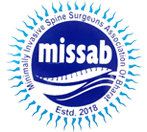
BOOK REVIEW – MISS
MINIMAALY INVASIVE SPINE SURGERY ASSOCIATION EDITED BY

Editor : Arvind G Kulkarni
Section : 7
Chapters : 41
Pages : 388
Publisher : Jaypee Brothers Medical Publishers (P) Ltd, New Delhi
This single volume book on “minimal invasive spine surgery” edited by Dr. Arvind Kulkarni is a detailed compilation of the entire spectrum of minimally invasive spine surgery (MISS) techniques and is published under the aeges of the Minimally Invasive Spine Surgeons of India Society. It comprises a total of 42 chapters divided into 7 sections written by 80 authors from across the globe, who are considered masters in the field of MISS. This book can be described as a detailed account of minimalism in spine surgery mainly and is dedicated to students and young spinal surgeons who are delicately poised at the initial steps of embarking upon the steep learning curve of MISS.
FUNDAMENTALS OF MINIMALLY INVASIVE SPINE SURGERY ASSOCIATION
In last two decades, MISS has evolved from an interesting procedure to be occasionally pursued by the interested surgeons, to mainstream surgical technique that may soon be mandatory for every neurosurgeon to learn and practice. The initiation of the book is by an introductory chapter that reviews the rationale and scope of applicability of the MISS procedures. Chapter 2 takes the readers through the odyssey of the evolutionary steps of MISS, undertaken by various renowned international masters of MISS. Each new development in the evolving techniques of MISS in the cervical, thoracic and lumbar regions has sought to equal or improve upon the effectiveness demonstrated by comparable open surgical techniques, while reducing iatrogenic tissue trauma and the resultant postoperative pain and disability, to produce an overall better outcome for the patients. The use of tubular retractors in the last decade in India has given a new dimension to MISS. Chapter 3 focuses on the evolution of tubes in India and gives an overview of the METRX system, its indications and usage. In Chapter 4, the authors brief the readers regarding various MISS approaches with their surgical indications, the relevant applied anatomy, as well as the pros and cons of each approach. The degree of radiation exposure and its hazards pertaining to specific MISS procedures have been discussed in Chapter 6 that is termed as “Hazards of radiation in MISS”. Focusing on the implications of acute radiation exposure on the health of the exposed individuals, exploring its relationship to the degree of dosage of radiation administered, and presenting the tips and suggestions that may be helpful in reducing the fluoroscopic radiation exposure are really commendable inclusions.
MISS IN CERVICAL SPINE
It comprises 4 chapters. The initial chapter (chapter 8) discusses in a very detailed manner, the technique of anterior cervical discectomy (ACD) without fusion. The review of class 1 studies that compare ACD with and without fusion is appreciable. The author concluded that there is lack of superiority of anterior cervical discectomy with fusion (ACDF) over ACD that is performed without a fusion procedure, as literature suggests that the presence of a single-level kyphosis does not affect the entire cervical sagittal balance. Although the author mentions his personal experience of 350 cases and the early outcome of ACD, ACDF, and anterior cervical discectomy with fusion and instrumentation [ACDFI], a long-term follow up is lacking and should be worth mentioning. Chapter 9 and 10 deal with the technical aspects of posterior cervical decompression utilizing a tubular retractor. In chapter 11, the indications for performing a minimal invasive transarticular C1-C2 fixation, a detailed description of its technique, the relevant surgical anatomy and the required preoperative assessment is summarized well. The advantages of the technique are reduced surgical time, less blood loss, a lower incidence of post-operative neck pain and an enhanced precision. Thus, a greater improvement in neck disability indices is obtained with a lesser incidence of inadvertent complications at the occipitocervical or the C2-3 joints in the long run.
MISS IN LUMBAR SPINE--NON-INSTRUMENTED
This section consists of 10 chapters written with the aim of providing information regarding the options available in the MISS technique for the treatment of lumbar spine pathology. The concept of “three stories of house” in relation to the lumbar spinal segment is an appropriate model to understand the basis of microdiscectomy (chapter 12). Moreover, the applied anatomy is described very well with graphical representations. The chapter also presents a safer method of microdiscectomy with tips and tricks to prevent complications during surgery. The author does a tremendous job in discussing the philosophy and the basis of percutaneous endoscopic lumbar discectomy (PELD) by the transforaminal approach in chapter 13. The applied anatomy of the foramen, as well as the indications and the technical pearls of PELD are presented in the next chapter (chapter 14). It will help a lot of residents and young spinal surgeons to understand the procedure in a three-dimensional perspective. An advice by the author that should be applauded is that transforaminal endoscopic surgery has a steep learning curve for some surgeons, and often translates into a long and shallow learning curve after the principle of foraminal decompression is mastered (chapter 15). The author has also declared that a good outcome is possible in 85% of the patients following this surgery. The use of this approach can be extended for performing a percutaneous discectomy and drainage of an abscess as well as for establishing the diagnosis and for the treatment of spondylodiscitis (chapter 16). Further chapters take the readers through the pros and cons of microlumbar discectomy and microendoscopic discectomy (utilizing the Destandau’s system and the METRX system) in various types of lumbar disc herniations and canal stenosis.
MISS IN THE LUMBAR SPINE -–INSTRUMENTED FUSION
Six chapters have compiled all the possible details about minimal invasive fusion techniques, mainly the translumbar interbody fusion (TLIF) technique. In chapters 23 and 24, the author exposes the readers to the technical pearls and nuances required to be focused upon during the performance of surgery. The technical details are elaborate with graphical representations and colourful images. Chapters 25 and 26 analyze the surgical outcome of MISS decompression and fusion (MISS TLIF) surgery. The authors conclude that MISS does not provide any clear advantage over the conventional non-fusion surgery like decompression and discectomy. The short-term outcome for fusion surgeries is in favour of MISS; however, there is no clear advantage in the medium-term outcome of MISS over the conventional procedures. There may be some advantage of MISS in special situations like performance of surgery in elderly and obese patients. The infection rate of the open spine surgery is 0.5-16%; comparatively, the infection rate during the performance of MISS is in the range of 0.07-7%. The prevention and management of superficial surgical site infection (SSSI) is highlighted in chapter 27.
TUMORS, INFECTION, AND OSTEOPOROSIS
Four chapters provide the basis for the MISS procedure in the management of tumours, infection and osteoporosis. Detailed steps for the performance of a vertebroplasty and kyphoplasty with three types of techniques have been provided. This includes the transpedicular bilateral, extrapedicular unilateral, and the open translaminar approaches. A review of literature regarding the complications of a vertebroplasty have been summarized well. These include cement leakage (40%), thermal injury, cement embolism (3-23%) and adjacent vertebral body fracture (18.9%). Overall, the authors are in favour of a kyphoplasty over a vertebroplasty owing to the fewer incidences of cement leakage in the former procedure and the ability of a kyphoplasty to also ensure deformity correction.
PAIN MANAGEMENT
It is a short review section consisting of three chapters. Chapters 32 and 33 describe the procedure of epidural steroid injection and radiofrequency ablation of facet joint in a stepwise manner utilizing the cervical, lumbar and sacral routes. Chapter 34 discusses the etiology of failed back syndrome and the various modalities of treatment suggested, such as pharmacological intervention, pain blocks, percutaneous adhesiolysis and spinal cord stimulation. The surgical results of these procedures reported in various studies in the literature have also been presented.
RECENT ADVANCES IN MISS
The recent advances in the MISS procedure compiled by the editor in the last section of the book have been presented in 8 different chapters. Chapter 35 deals with the indications and techniques of robotic surgeries performed using MISS. The complications encountered while utilizing robots in spine surgery are also discussed. Moreover, the authors also shared the experience in 220 cases with an outstanding outcome. In chapters 36 and 37, the authors discuss the principle and the use of the neuronavigation system, the advantage of an O-arm over two- and three-dimensional fluoroscopy during the performance of MISS, as well as a tabular representation of the results of various series utilizing neuronavigation assisted MISS. An estimation of accuracy of the procedure in pedicle screw fixation has also been discussed.
SUMMARY OF THE BOOK REVIEW
This book is well- compiled and is very easy to understand. We strongly believe that this book will motivate spinal surgeons, especially the younger ones, to become more interested in the field of endoscopic spine surgery and in utilizing minimally invasive methods for performing spinal fusions. The book has the advantage of helping in overcoming the steep learning curve of MISS. The chapters have been written by eminent national and international spine surgeons who are masters in the MISS technique and the book is a representation of their vast experience. The compilations within the book encompass every gamut of MISS; however, the description of a few additional techniques could have completed the entire spectrum of minimally invasive spinal surgery. Some of these include MISS oblique lumbar interbody fusion (MISS OLIF), endoscopic transnasal odontoidectomy and fusion, endoscopic MISS TLIF, minimally invasive methods for scoliosis correction and MISS dynamic stabilization. Elements of repetition could have been prevented by avoiding the description of the same procedure despite their varied indications (section 3 and 4). The comprehensive coverage of topics in this book is further enhanced by a comprehensive review of the literature with references up to 2015; however, references by Indian authors are lacking. We are looking forward to subsequent editions and supplements of this book in the near future that include a more comprehensive coverage of recent advancements in the MISS techniques.
The compilation of very clear and informative photographs as well as well-planned and properly organized descriptions of procedures are the hallmarks of this book. A description of the applied anatomy relevant to spinal regions, a comprehensive literature review and a detailed description of steps of the procedure along with the technical pearls will really help the surgeons interested in the MISS technique to negotiate the obstacles and prevent the surgical complications during surgery. We strongly recommend this book as it is relevant for all spinal surgeons interested in MISS, including those who are at the beginning of their careers as well as those who are well-experienced in the field.
BOOK REVIEW
Year : 2018 | Volume : 66 | Issue : 4 | Page : 1219-1221
Minimal invasive spine surgery
Jayesh Sardhara1, Sudhir Dube2
1 Department of Neurosurgery, Sanjay Gandhi Postgraduate Institute of Medical Sciences, Lucknow, Uttar Pradesh, India
2 Minimally Invasive Neurosurgery, Medanta Institute of Neuroscience, Medanta The Medicity, Sector 38, Gurgaon, Haryana, India
